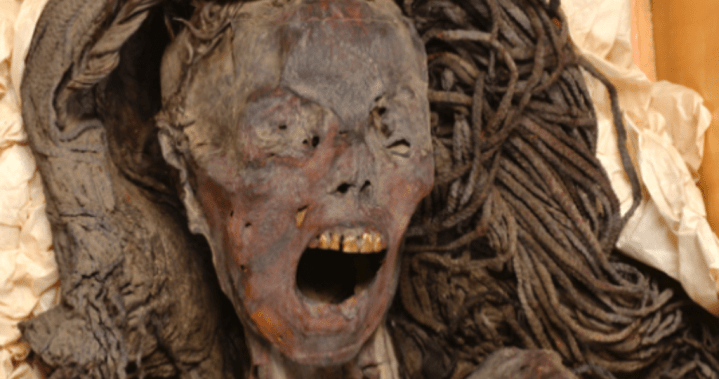For roughly 3,500 years, the remains of an ancient Egyptian woman have preserved what may have been her final expression before death: an anguished shriek.
The mummy, known as the “Screaming Woman,” has been the subject of intense curiosity since it was first discovered in 1935. Her mouth hangs wide open with her mostly-intact top teeth bared, as if she were howling in pain. Her sunken eyes and black, leather-like skin add to her startling appearance.
While the woman’s identity has been lost to time, researchers from Egypt are trying to learn as much as possible from her remains — and they believe they’ve cracked the case of her unsettling facial expression.
Sahar Saleem, a radiology professor from Cairo University, and study co-author Samia El-Merghani, of the Egyptian Ministry of Tourism and Antiquities, performed a “virtual dissection” of the mummy using CT scans. The results of their research were published Friday in the journal Frontiers in Medicine.
They believe that the Screaming Woman’s face is contorted that way because of a rare form of rigor mortis called cadaveric spasm, which can freeze a person’s body in their final action just before death.
“It occurs after severe physical or emotional activity, leading to immediate postmortem rigor as the contracted muscles become rigid immediately following death and are unable to relax,” the study reads.
If it’s true that the woman’s expression is a result of cadaveric spasm, this indicates that she “died screaming from agony or pain,” the study says. Embalmers may have mummified the woman’s body before rigor mortis could dissipate, forever preserving her final scream.
Black-and-white photos showing the front and side profile of the “Screaming Woman” mummy.
Sahar Saleem/Frontiers in Medicine
The researchers concede that the cadaveric spasm is not fully understood. The phenomenon is mostly observed in forensic pathology and only impacts one group of muscles, not the whole body.
Not all scholars are convinced by this theory. The study notes that other academics have hypothesized that the putrefaction process or the compressive force of the wrappings used in embalming could have affected her facial features. Or perhaps her embalmers neglected to close her mouth before the mummification process.
Breaking news from Canada and around the world
sent to your email, as it happens.

Get breaking National news
For news impacting Canada and around the world, sign up for breaking news alerts delivered directly to you when they happen.
The researchers find the latter argument to be unlikely though, due to clues left behind in the woman’s burial chamber. There’s evidence that the woman’s embalmers used expensive, imported ingredients to prepare her body for burial, including juniper oil and frankincense resin. Plus, she was buried with fine jewelry — two scarab beetle rings made of gold, silver and jasper — and embalmers affixed to her head a luxurious, long haired-wig made from date palm fibres.
All this evidence indicates that the Screaming Woman was a wealthy individual who was mummified with care. Instead of simply neglecting to close the woman’s mouth, researcher suggest that embalmers were unable to shut it due to the stiffening of her muscles.
There is some conflicting evidence, however. The woman’s embalmers did not remove her internal organs during the mummification process — contrary to typical practice at the time. Finding mummies with their organs intact is more common for individuals that were in the middle or lower classes of ancient Egyptian society.
But the location of the woman’s burial place adds extra evidence to the theory that she was a high-ranking individual.
Her remains were found during a 1935 archaeological expedition at Deir el-Bahari near Luxor at the site of the ancient city of Thebes. She was buried in the tomb of a high-ranking official named Senmut, an architect who oversaw royal works and was the reputed lover of Queen Hatshepsut, who reigned during ancient Egypt’s glittering New Kingdom period.
The woman’s coffin was found in a burial chamber beneath Senmut’s family tomb.
“She was likely a close family member to be buried and share the family’s eternal resting place,” Saleem told Reuters.
Still, many questions about the enigmatic woman are left unanswered. Not just her identity, but her cause of death as well.
“We frequently cannot determine the cause of death in a mummy unless there is CT evidence of fatal trauma,” Saleen said.
What the CT scans do show, however, is that the woman was about 48 years old when she died. She likely lived with mild arthritis in her spine and had lost some teeth.
The Screaming Woman is not the only mummy to be found with a facial expression resembling a shriek, the study notes.
Another example of a screaming mummy is the remains of Prince Pentawere, the son of Pharaoh Ramesses III, who was put to death for plotting to assassinate his father.
“Pentawere’s body was barely embalmed, which may indicate that the embalmers neglected to keep his mouth closed,” the study reads.
— with files from Reuters
© 2024 Global News, a division of Corus Entertainment Inc.






